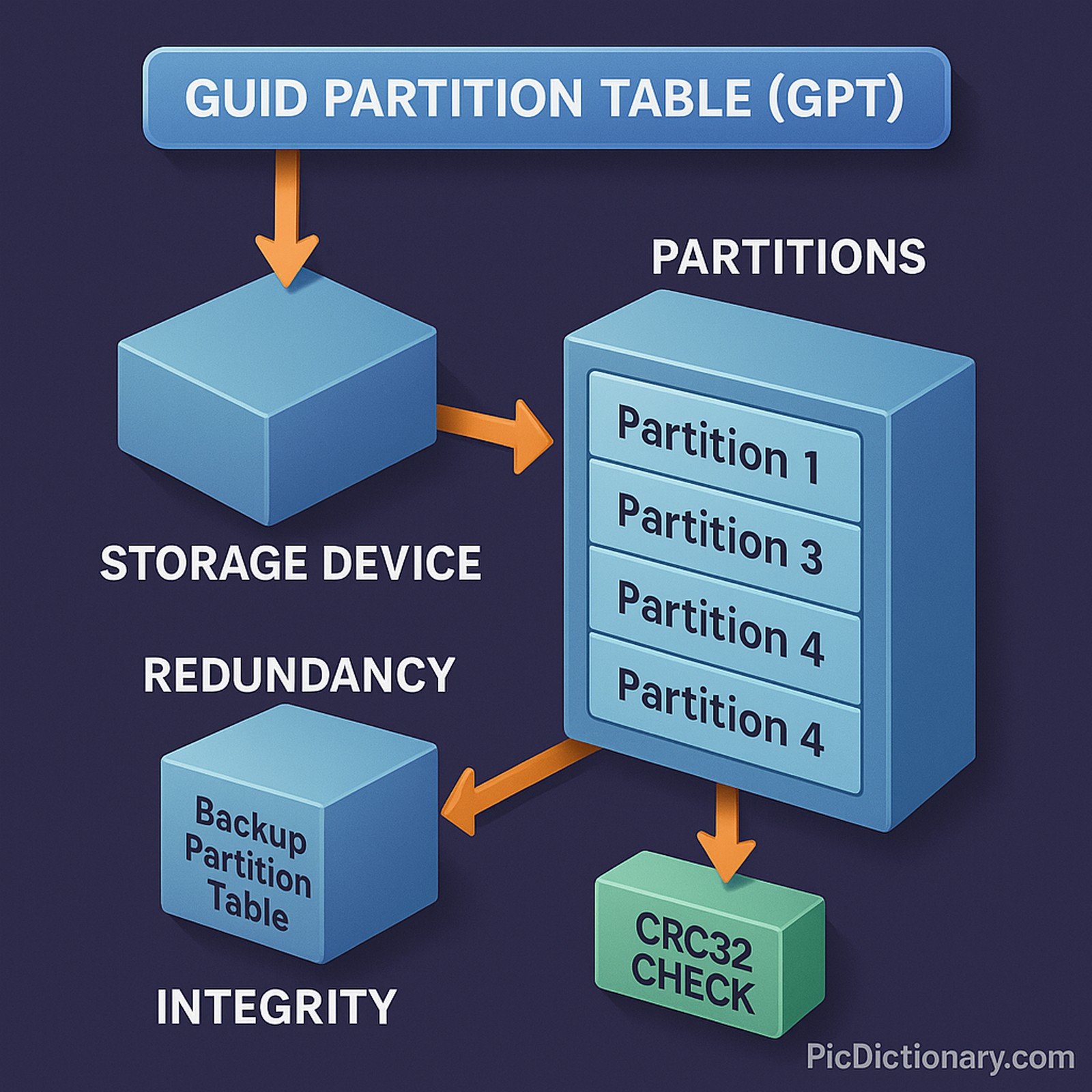GUID Partition Table (GPT)

Quick Navigation:
- GUID Partition Table (GPT) Definition
- GUID Partition Table (GPT) Explained Easy
- GUID Partition Table (GPT) Origin
- GUID Partition Table (GPT) Etymology
- GUID Partition Table (GPT) Usage Trends
- GUID Partition Table (GPT) Usage
- GUID Partition Table (GPT) Examples in Context
- GUID Partition Table (GPT) FAQ
- GUID Partition Table (GPT) Related Words
GUID Partition Table (GPT) Definition
The GUID Partition Table (GPT) is a standard for the layout of partition tables on a physical storage device, such as a hard drive or SSD, using globally unique identifiers (GUIDs). It is part of the Unified Extensible Firmware Interface (UEFI) standard, which replaced the older BIOS system. GPT allows for a nearly unlimited number of partitions (in practice, most systems support up to 128), supports drives larger than 2 terabytes, and includes redundancy with backup partition tables and CRC32 checks to improve data integrity and recovery.
GUID Partition Table (GPT) Explained Easy
Think of a bookshelf where each book has a unique number and clear space, and you can have as many shelves as you want. Older systems had only a small shelf and limited space. GPT is like a super bookshelf that can hold many books (partitions) and is designed to never get confused about where each book is placed, even if something bad happens.
GUID Partition Table (GPT) Origin
GPT was introduced as part of the UEFI standard, developed by Intel in the late 1990s and early 2000s. It was created to overcome the limitations of the traditional Master Boot Record (MBR) partitioning scheme, which was restricted by size and structure constraints.
GUID Partition Table (GPT) Etymology
The term "GUID Partition Table" comes from the use of GUIDs to uniquely identify partitions on a disk.
GUID Partition Table (GPT) Usage Trends
Over the past decade, GPT has become the default partitioning system on modern computers, especially with the widespread adoption of UEFI firmware. It is now standard on most operating systems including Windows, Linux, and macOS, especially for new installations and larger storage devices.
GUID Partition Table (GPT) Usage
- Formal/Technical Tagging:
- Disk Partitioning
- UEFI Firmware
- Data Storage - Typical Collocations:
- "GPT partition table"
- "convert MBR to GPT"
- "GPT disk initialization"
- "GPT schema support"
GUID Partition Table (GPT) Examples in Context
- Modern Windows installations on UEFI systems require a GUID Partition Table (GPT) disk.
- External drives larger than 2TB often come pre-formatted with a GPT partition table.
- System administrators use disk management tools to convert old MBR drives to GPT for better compatibility and scalability.
GUID Partition Table (GPT) FAQ
- What is GUID Partition Table (GPT)?
It is a partitioning system that uses globally unique identifiers for partitions and supports large storage devices. - How does GPT differ from MBR?
GPT supports more partitions, larger disk sizes, and has redundancy features, unlike the limited MBR system. - Is GPT required for UEFI?
Yes, most UEFI systems require drives to be partitioned with GPT to boot properly. - Can you convert MBR to GPT without losing data?
Some tools allow conversion without data loss, but a full backup is always recommended. - Is GPT compatible with all operating systems?
Most modern operating systems support GPT, but older OS versions might not. - Why does GPT support larger drives?
It uses 64-bit addressing, which allows handling disks larger than 2TB. - How do I check if my drive is GPT or MBR?
You can use disk management tools in Windows or command-line utilities in Linux/macOS to check. - Does GPT have any redundancy features?
Yes, it stores a backup partition table at the end of the disk and uses CRC32 checks. - What happens if the GPT table is corrupted?
Backup partition tables and checksums help recover or rebuild a corrupted GPT. - Can GPT be used on external drives?
Yes, GPT is commonly used on large external hard drives and SSDs for better compatibility.

GUID Partition Table (GPT) Related Words
- Categories/Topics:
- Disk Partitioning
- Data Storage
- UEFI Firmware
Did you know?
Apple’s Intel-based Macs have used the GUID Partition Table (GPT) as the default partition scheme since Mac OS X 10.4 (Tiger), making it one of the first mainstream implementations to fully embrace GPT for both internal and external drives.
PicDictionary.com is an online dictionary in pictures. If you have questions or suggestions, please reach out to us on WhatsApp or Twitter.Authors | Arjun Vishnu | @ArjunAndVishnu

I am Vishnu. I like AI, Linux, Single Board Computers, and Cloud Computing. I create the web & video content, and I also write for popular websites.
My younger brother, Arjun handles image & video editing. Together, we run a YouTube Channel that's focused on reviewing gadgets and explaining technology.



Comments powered by CComment